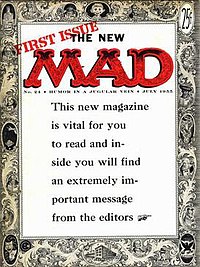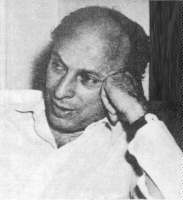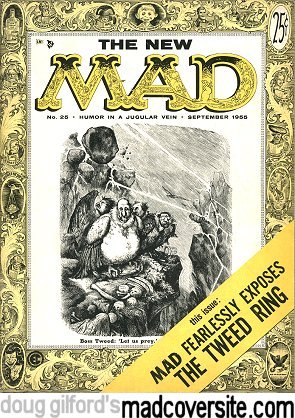Noget af det sidste Harvey Kurtzman, vi mangler at få genoptrykt i dets helhed, er de sh numre af MAD i magazine format, som han redigerede før han forlod EC.
fra http://www.instantwonder.com/artist-kurtzman.html
Kurtzman edited only five magazine issues of Mad. Disagreements with Gaines led to Kurtzman abandoning Mad in 1955. In Al Feldstein‘s hands, the Kurtzman-created Mad became the only EC publication to survive the 1950s. Its popularity has continued to the present. Ironically, while Kurtzman’s comic book issues of Mad have been extensively reprinted, his magazine Mad remains literally untouched.
Kurtzman returned to Mad in 1985, producing a handful of stories in collaboration with Will Elder and Sarah Downs. 1986 saw Kurtzman’s run of the comic book Mad published in hardcover by Cochran.
Harvey Kurtzman’s work profoundly impacted 20th century American culture. His large legacy of serious and satirical work set standards for quality and intelligence that remain unequalled. His satires and parodies for Mad and his other satire magazines redefined the role of parody in American culture, and his influence on the first generation of underground cartoonists is undeniable. Though Kurtzman’s major work was created in the 1950s and early 1960s, it continues to impact and influence comics creators today. -Frank Young


fra www.aaacaricatures.com/madmagazine.html
With issue 24 (July, 1955), Mad switched to a magazine format. The “extremely important message” was “Please buy this magazine!”
In 1955, with issue 24, the comic book was converted into a magazine. The popular myth is that this was done to escape the strictures of the Comics Code Authority, which was imposed in 1955 following United States Senate hearings on juvenile delinquency. Actually, Kurtzman received a lucrative offer from the publisher of Pageant and only stayed when Gaines agreed to convert Mad to a similarly “slick” magazine. The immediate practical result was that Mad acquired a broader range in both subject matter and presentation. Magazines had wider distribution than comic books, and a more adult readership.
However, the Comics Code Authority had proven fatal to Gaines’ EC Comics line. Publisher Gaines had suffered both financially and creatively from targeted industry censorship, and the enmity of his fellow publishers. EC’s national distributor, Leader News, was the nation’s weakest and did not have the clout to withstand an undeclared industry boycott of EC product; the company’s comics were frequently returned still in their original, unopened bundles. These factors combined to drive all EC comics from the stands, except for Mad, which was too profitable to ignore. The company’s financial status grew shakier in 1956 when Leader News declared bankruptcy, leaving EC over $100,000 in debt. Only the Gaines family’s investment of capital and a fortuitous deal with the much stronger American News distributor kept Mad afloat.
After the bulk of EC’s line was cancelled in 1954-55, the company was completely reliant on the improving fortunes of Mad. In a creative showdown, Kurtzman insisted upon a 51% share in the company; when Gaines rejected the demand, EC was without its creative dynamo and Kurtzman was without the magazine that crystallized his talents. Al Feldstein returned to EC, and oversaw Mad during its greatest heights of circulation. Taking over with issue #29, Feldstein set to work assembling a phalanx of talented humor writers and cartoonists.
fra goodcomics.comicbookresources.com/…/
Gaines was asked about the issue in an interview with Steve Ringgenberg:
RINGGENBERG: Did you change Mad from a comics format to a magazine format to escape the censors?
GAINES: No. No, I did not. I changed it because Harvey Kurtzman, my then editor, got a very lucrative offer from, I believe, pagent magazine, and he had, prior to that time, evinced an interest in changing Mad into a magazine. At the time I didn’t think I wanted to because I didn’t know anything about publishing magazines. I was a comics publisher. But, remembering this interest, when he got this offer, I countered his offer by saying I would allow him to change Mad into a magazine, which proved to be a very lucky step for me. But that’s why it was changed. It was not changed to avoid the Code. Now, as a result of this, it did avoid the Code, but that’s not why I did it. If Harvey had not gotten that offer from Pageant, Mad probably never would have changed format.

Og noget af Kurtzmans magazine run er blevet genoptrykt i en lækker softcover, fra www.kenpiercebooks.com/mad.htm

Mad About the Fifties
Of all the recent collections assembled from the archives of MAD magazine, this volume might be the most interesting. It shows the beginnings of the magazine as a comic book, its transformation into a “slick” three years later in 1955, and its settling down into a familiar format under the stewardship of Al Feldstein. The early material shows quite clearly what the hubbub was all about: Harvey Kurtzman, Willie Elder, Wally Wood, and the rest parody comic characters with a zany zest that is infectious. This book boasts reproductions of MAD’s comic book highlights, including “Starchie,” “Superduperman,” and “Batboy and Rubin.” Many readers will remember these stories, if not from the first time around, then from the Ballantine paperback collections so ubiquitous in the 1960s and ’70s. MAD About the Fifties shows MAD’s tentative transformation into an American institution; this tentativeness, far from being a drawback, results in the only experimental period in the humor magazine’s 45-year run (who knew that Stan Freberg, Bob and Ray, and Ernie Kovacs contributed?). Kurtzman’s departure in 1956 brought in Al Feldstein, who would expand the magazine’s appeal from the thousands to the millions. Purists are still debating whether this was a good idea or a sellout–MAD About the Fifties allows you to decide for yourself. Art by Wood, Elder, Kurtzman, Davis, Jaffee, Martin, and all the rest of the Usual Gang Of Idiots. MAD About the Fifties contains more of their gems; it deserves a space in any MAD reader’s library.
fra Wikipedia:
Pageant indirectly figures into the history of Harvey Kurtzman‘s Mad, triggering the switch of Mad from a comic book to a magazine. In the early 1950s, Pageant did an article about the comic book Mad, illustrating it with an original double-page cartoon showing a parade of Mad characters. The drawing was created especially for Pageant by Kurtzman and Will Elder. Not long after that, Kurtzman received an offer to edit Pageant.

Men der er én måde at få de sjældne Kurtzman sh magazine format MAD blade, og det er på DVD-Rom, hvor hele serien er blevet samlet i én dejlig pakke:

Og sådan her ser nr. 25 ud:

fra http://www.collectmad.com/madcoversite/index-covers.html
Al Feldstein føler, at Harvey Kurtzman har fået en alt for stor del af æren for MADs succés, og har dette at sige om Harvey Kurtzman og MAD bladet:
fra http://www.collectmad.com/madcoversite/index-feldstein.html
AF – Ahhhh… you have touched on another sore point with me. Throughout my career as editor of MAD (1956-1984), I was never able to overcome the cult-myth reputation of Harvey Kurtzman who failed miserably at being able to edit/publish another successful MAD-type magazine/imitation once he left the creative, brainstorming, competitive, advisory, chiding, encouraging atmosphere of E.C. I painfully remember many articles about Mad published in the ’70’s, N.Y. Times Sunday Magazine, etc., about its infuence on America’s youth through the late fifties and sixties, well after Harvey had left and I’d taken over, and never mentioning me, but crediting Harvey for its success.
Harvey was a great talent, I will be the first to admit, which is why I convinced Bill to hire him, gave him work in my books, encouraged Bill to give him his own titles, Two-Fisted Tales and Frontline Combat, and suggested that his third title be an adult humor book, even to the title, recommending that from phrases used by the Cryptkeeper, Old Witch, etc., like Welcome to my E.C. MAD Mag, Tales From…, that we should call it E.C.s MAD Mag… which Harvey, rightly so, shortened to MAD.
His initial efforts were to humorize the story genres being published by E.C. in its other titles, i.e. a funny sci-fi story, a ridiculous horror story, etc.. It wasn’t until I chided him to humorize more recognizeable comic book properties, i.e. The Lone Ranger (The Lone Stranger), Superman (Superdooperman), etc., that the magazine began to show some promise. And further chiding on my part pushed him into satirizing other subjects throughout Americana. My own magazine, Panic, an admitted imitation of MAD, was a hastily-written-and-edited (one week, as opposed to Harvey’s 8-week, later 4-week schedule) that foreshadowed my future success with MAD.
It is interesting that, in the annals of fandom, Harvey, due to his cult-myth following, and Bill, due to his publishing successful magazines created by others, and Wally Wood, whom I encouraged to break loose from the clutches of Harry Harrison and start working for me on his own as an individual talent, are all in the “Will Eisner Comic Hall of Fame” and I have never been awarded that honor. Such is life.

